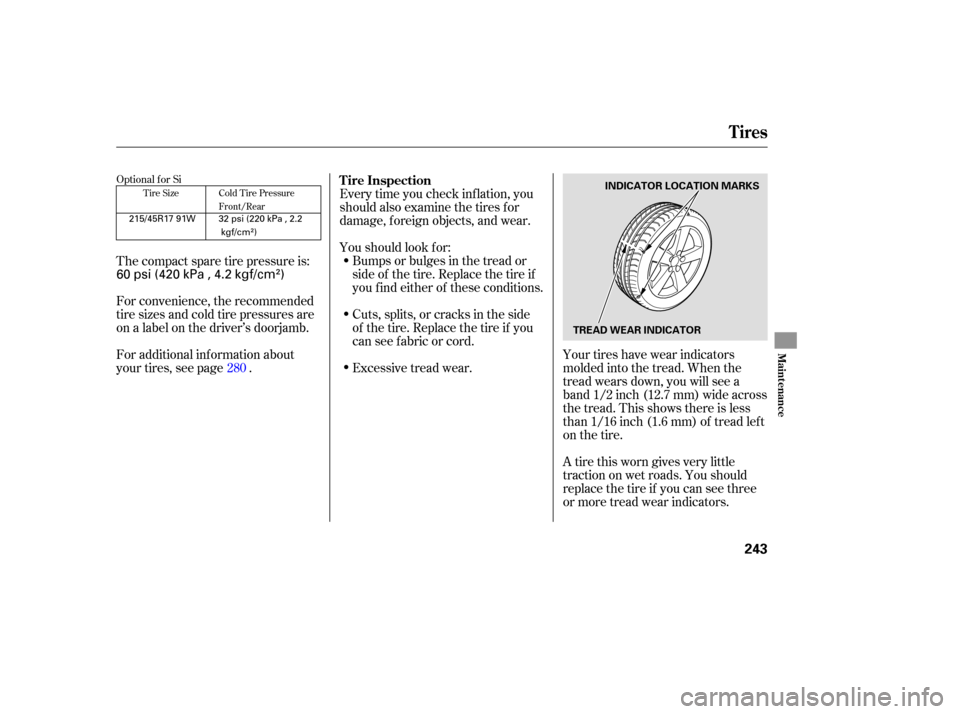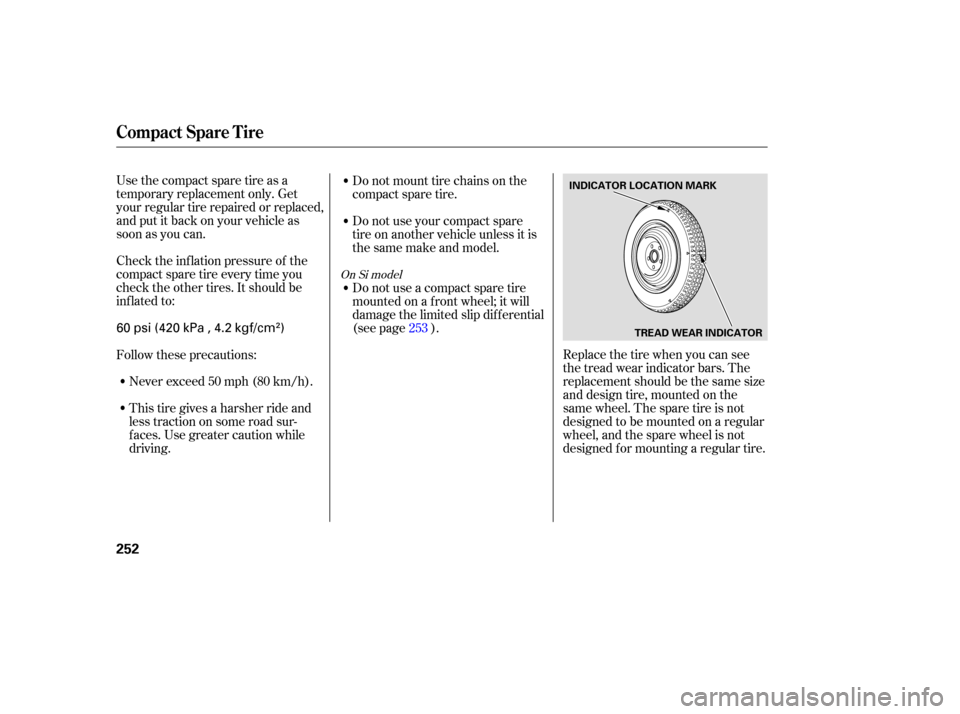Page 246 of 307

The following charts show the
recommended cold tire pressures f or
most normal and high-speed driving
conditions.
If you check air pressures when the
tires are hot [driven f or several miles
(kilometers)], you will see readings 4
to6psi(30to40kPa,0.3to0.4
kgf /cm ) higher than the cold
readings. This is normal. Do not let
air out to match the recommended
cold air pressure. The tire will be
underinf lated.
Youshouldgetyourowntire
pressure gauge and use it whenever
you check your tire pressures. This
will make it easier f or you to tell if a
pressure loss is due to a tire problem
and not due to a variation between
gauges.
While tubeless tires have some
ability to self -seal if they are
punctured, you should look closely
for punctures if a tire starts losing
pressure.
Use a gauge to measure the air
pressure in each tire at least once a
month. Even tires that are in good
condition may lose 1 to 2 psi (10 to
20 kPa, 0.1 to 0.2 kgf /cm ) per
month. Remember to check the
sparetireatthesametime.
Check the air pressures when the
tires are cold. This means the
vehicle has been parked f or at least 3
hours, or driven less than 1 mile (1.6
km). Add or release air, if needed, to
match the recommended cold tire
pressuresonthispage.
Tire Size Cold Tire Pressure
Front/Rear
Tire Size Cold Tire Pressure Front/Rear
Tire Size Cold Tire Pressure Front:
Rear:
DX and Canadian DX-G
LX, EX
Si
Tires
Recommended T ire Pressures
242
P195/65R15 89H
P215/45R17 87V
P205/55R16 89H 32 psi (220 kPa , 2.2
kgf/cm
)
32 psi (220 kPa , 2.2 kgf/cm
)
29 psi (200 kPa , 2.0 kgf/cm
)
30 psi (210 kPa , 2.1
kgf/cm
)
�����—�����—�����y�
����
�
��
���y���
�(�+���������y���������y
Page 247 of 307

Every time you check inf lation, you
should also examine the tires f or
damage, f oreign objects, and wear.
Youshouldlookfor:Bumps or bulges in the tread or
side of the tire. Replace the tire if
youfindeitherof theseconditions.
Cuts, splits, or cracks in the side
of the tire. Replace the tire if you
can see f abric or cord.
Excessive tread wear. Your tires have wear indicators
molded into the tread. When the
tread wears down, you will see a
band 1/2 inch (12.7 mm) wide across
the tread. This shows there is less
than 1/16 inch (1.6 mm) of tread lef t
on the tire.
A tire this worn gives very little
traction on wet roads. You should
replace the tire if you can see three
or more tread wear indicators.
For additional inf ormation about
your tires, see page . For convenience, the recommended
tire sizes and cold tire pressures are
on a label on the driver’s doorjamb. Thecompactsparetirepressureis:
280Cold Tire Pressure
Front/Rear
Tire Size
Optional f or SiTire Inspection
Tires
Maint enance
243
INDICATOR LOCATION MARKS
TREAD WEAR INDICATOR
60 psi (420 kPa , 4.2 kgf/cm)
215/45R17 91W 32 psi (220 kPa , 2.2 kgf/cm
)
�����—�����—�����y�
����
�
������y���
�(�+���������y���������y
Page 255 of 307

This section covers the more
common problems that motorists
experience with their vehicles. It
gives you inf ormation about how to
safely evaluate the problem and what
to do to correct it. If the problem has
stranded you on the side of the road,
you may be able to get going again.
If not, you will also f ind instructions
on getting your vehicle towed.......................
Compact Spare Tire .252
....................
Changing a Flat Tire .253
.............
If the Engine Won’t Start .257
................................
Jump Starting .259
..............
If the Engine Overheats .261
.........
Low Oil Pressure Indicator .263
..........
Charging System Indicator .263
.......
Malf unction Indicator Lamp .264
...............
Brake System Indicator .265
..............................................
Fuses .266
..............................
Fuse Locations .270
......................
Emergency Towing .272
Taking Care of the Unexpected
T aking Care of t he Unexpect ed
251
�����—�����—�����y�
����
��������y���
�(�+���������y���������y
Page 256 of 307

Use the compact spare tire as a
temporary replacement only. Get
your regular tire repaired or replaced,
and put it back on your vehicle as
soon as you can.
Check the inf lation pressure of the
compact spare tire every time you
check the other tires. It should be
inf lated to:Replace the tire when you can see
the tread wear indicator bars. The
replacement should be the same size
and design tire, mounted on the
same wheel. The spare tire is not
designed to be mounted on a regular
wheel, and the spare wheel is not
designed f or mounting a regular tire.
Do not use your compact spare
tire on another vehicle unless it is
thesamemakeandmodel. Do not mount tire chains on the
compact spare tire.
Do not use a compact spare tire
mounted on a f ront wheel; it will
damage the limited slip dif f erential
(see page ).
This tire gives a harsher ride and
less traction on some road sur-
f aces. Use greater caution while
driving. Never exceed 50 mph (80 km/h).
Follow these precautions: 253
On Si model
Compact Spare Tire
252
INDICATOR LOCATION MARK
TREAD WEAR INDICATOR
60 psi (420 kPa , 4.2 kgf/cm)
�����—�����—�����y�
����
������
�y���
�(�+���������y���������y
Page 257 of 307

CONT INUED
If you have a f lat tire while driving,
stop in a saf e place to change it.
Drive slowly along the shoulder until
you get to an exit or an area that is
far away from the traffic lanes.
Thesizedifferencemayalsocause
damage to the dif f erential, so do not
mount the compact spare on the
f ront. If either f ront tire goes f lat,
removethereartireonthatsame
side, mount the compact spare tire
on the rear, then mount the rear tire
on the f ront.Turn on the hazard warning lights,
and turn the ignition switch to the
LOCK (0) position. Have all
passengers get out of the vehicle
while you change the tire. Park the vehicle on f irm, level, and
non-slippery ground. Put the
transmission in Park (automatic)
or reverse (manual). Apply the
parking brake.Open the trunk. Raise the trunk
f loor by lif ting up on the back edge.
Unscrew the wing bolt, and take
the spare tire out of its well. Take the tool kit case out of the
trunk.
Thecompactsparetireissmaller
than a standard tire, and it will affect
the vehicle’s handling. Drive
cautiously when the spare is
mounted on your vehicle.
5. 4.
3.
2. 1.
On Si model only
Changing a Flat Tire
T aking Care of t he Unexpect ed
253
SPARE TIRE
TRUNK FLOOR JACK TOOL CASE
The vehicle can easily roll off
the jack, seriously injuring
anyone underneath.
Follow the directions for
changing a tire exactly, and
never get under the vehicle
when it is supported only by the
jack.
�����—�����—�����y�
����
����
���y���
�(�+���������y���������y
Page 259 of 307
CONT INUED
Do not attempt to forcibly pry the
wheel cover of f with a screwdriver
or other tool. The wheel cover
cannot be removed without f irst
removing the wheel nuts.Bef ore mounting the spare tire,
wipeanydirtoff themounting
surface of the wheel and hub with
a clean cloth. Wipe the hub
carefully;itmaybehotfrom
driving.Put on the spare tire. Put the
wheel nuts back on f inger-tight,
then tighten them in a crisscross
pattern with the wheel nut wrench
until the wheel is f irmly against
the hub. Do not try to tighten
them f ully.
Lower the vehicle to the ground,
and remove the jack.
11.
10.
12.
Changing a Flat Tire
T aking Care of t he Unexpect ed
255
WHEEL NUTS WHEEL COVER BRAKE HUB
WHEEL NUTS
�����—�����—�����y�
����
��������y���
�(�+���������y���������y
DX, Canadian DX-G , and LX models
Page 260 of 307
Remove the center cap from the
flat tire.Place the flat tire face down in the
spare tire well.
Remove the spacer cone f rom the
wing bolt, turn it over, and put it
back on the bolt.
Secure the f lat tire by screwing
the wing bolt back into its hole.
Tighten the wheel nuts securely in
the same crisscross pattern. Have
the wheel nut torque checked at
the nearest automotive service
f acility.
Tighten the wheel nuts to:
14.
15.
13.
16.
17.
Changing a Flat Tire
256
WING BOLT
SPACER CONE
For
compact
spare tireFor normal
tire
80 lbf·ft (108 N·m , 11 kgf·m)
�����—�����—�����y�
����
��������y���
�(�+���������y���������y
OnEXandSimodelsintheU.S.,and
LX, EX, andSi models in Canada
Page 283 of 307

�µ�µ�µ
�Î
�Î
�Î
�Î �µ
�µ
�µ
�µ
�µ
�µ
�µ
�µ
�µ
�µ
�µ
�µ
�µ
�µ
�µ
�µ
�Î
�Î
�Î
�Î
�Î
�Î
�Î
�Î
�Î �Î
�Î �Î
�Î
�Î
�Î�Î
�Î
�Î �Î
�Î
�Î
�Î
Specif ications
Technical Inf ormation
279
Air Conditioning
Lights
Battery Fuses
Alignment
Tires
HFC-134a (R-134a)
14.1 15.9 oz (400 450 g)
12 V
12 V 60 W
12 V 51 W
Refrigerant type
Charge quantity
Lubricant oil type
28/8 WSP-10
12 V 12 V
12 V
12 V 21/5 W
12 V 21 W
12 V
12 V
12 V 5 W 8W 3CP
21 W
18 W
Headlights (HI)
Headlights (LO)
Front turn signal/Side marker/
Parking light
Rear turn signal lights
Stop/Taillights
Rear side marker lights
Back-up lights
High-mount brake light
License plate lights
Ceiling light
Spotlights
Trunk light
Capacity 36 AH/5 HR See page 271 or the fuse label
attached to the dashboard.
Interior
Under-hood See page 270 or the fuse box
cover.
Toe-in
Camber
Caster 0.00 in (0.0 mm)
0.08 in (2.0 mm)
0°
1°30’ 7°
P195/65R15 89H
12 V 3 CP
12 V P205/55R16 89H
P215/45R17 87V
12 V 12 V 47 AH/20 HR
45 AH/20 HR 60 psi (420 kPa , 4.2 kgf/cm
)
29 psi (200 kPa , 2.0 kgf/cm)
32 psi (220 kPa , 2.2 kgf/cm)
32 psi (220 kPa , 2.2 kgf/cm)
30 psi (210 kPa , 2.1 kgf/cm)
T125/70D16 96M
T125/70D15 95M
Size
Pressure
12 V 38 AH/5 HR 215/45R17 91W
8W Front
Rear
Front
Rear
Front
(HB3)
(HB4)
: All models except for EX and Si
1 : U.S.: DX, LX, EX
2 : Canada: DX, DX-G,LX, EX
3: Si Front/Rear
Spare
Front/Rear
Front
Rear
Spare
1:
2:
3:
4:
5:
6: U.S. DX, Canada DX, DX-G
LX,EX
Si (all season tires)
U.S.: DX, LX, EX, Canada: DX, DX-G, LX, EX
Optional for Si (summer tires)
Si
1
2
3
3 4
6
1
2, 5
1
3 1
2
3
5
�����—�����—�����y�
����
��������y���
�(�+���������y���������y